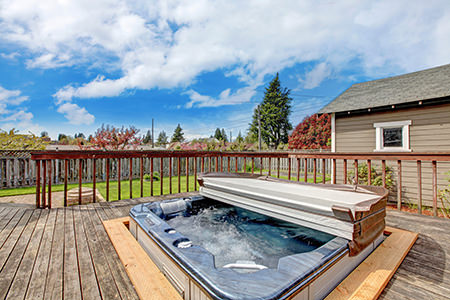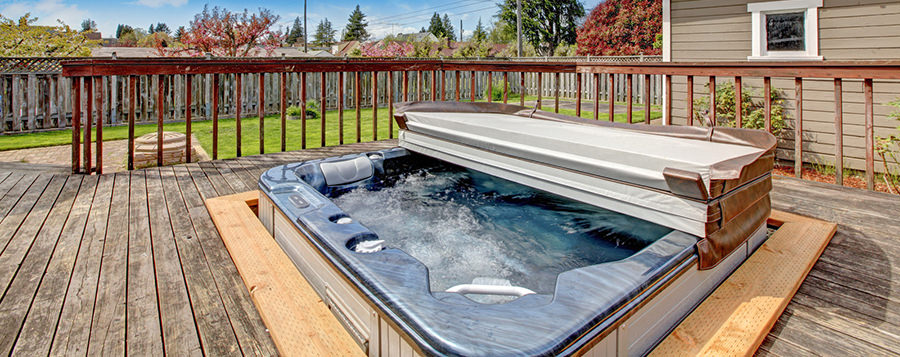
Your hot tub cover is one of those things that you don’t really think about until it’s either goes wrong or needs replacing. It’s one of those items that just quietly sit there getting on with its job without being noticed! However, your hot tub cover has a vital role to play in both protecting your hot tub and keeping it energy efficient so it’s very important to buy the right one and to care for your cover carefully.
Most hot tub manufacturers will supply new hot tubs with covers ready fitted. Depending on the quality of the hot tub, the cover may last a long time or, if you’re unlucky, it might be that the manufacturer cut corners with the cover and it might need replacing sooner rather than later. To a certain extent, from the manufacturer’s point of view, covers aren’t all that exciting to sell and hot tub purchasers often don’t really have the quality of the cover high on their priority list. It’s much more exciting to think about the size of the hot tub, how it’s filtration system works, how comfortable it is and how many jets it has rather than what the thermal efficiency of the hot tub cover is. Of course, many manufacturers provide high-quality covers with their hot tubs, but some at the lower end of the market inevitably do provide covers that are of lesser quality, will be less efficient and last a shorter amount of time than a
So, it might be that you need to replace your hot tub cover because it’s simply too old and worn out or you might have realized that the cover you currently have doesn’t suit your purposes or isn’t particularly thermally efficient. Either way, this guide is for you!
Let’s start off by having a look at some of the different types of cover available.
Soft hot tub covers
These are made of vinyl and just roll on and off the top of the hot tub. They are relatively inexpensive and are just designed for indoor hot tubs and provide a basic level of protection. They will prevent some evaporation of the water and also stop dust and indoor debris from getting into the hot tub. Soft covers are essentially useless for outdoor hot tubs as they offer little protection from the elements and very little thermal insulation. You might get away with using one outdoors in a very hot climate where insulation isn’t an issue but they are not really hardy enough to last very long outside.
Hard shell hot tub covers
These are the most commonly purchased covers and the type of cover that’s provided with most hot tubs. You need one of these if your hot tub is outside as it will prevent dirt and debris from getting inside the hot tub and also, most importantly, it will help to keep the heat in. These types of covers provide a great deal of thermal insulation and they prevent water evaporation as well. A good thermal hard shell cover will save you a lot of money on your energy bill as well as keeping your hot tub clean. They are weatherproof as too and usually come with a sloping top so that rainwater will disperse from them. The downside of hard shell covers is that they are relatively heavy. They are usually hinged in the middle and you might need to use a hot tub cover lifter to get them off the hot tub.
Seasonal or winter hot tub covers
You can use a seasonal or winter cover in combination with a hard shell cover to provide weather protection for the entire hot tub during the winter months. The seasonal or winter cover is essentially an especially produced tarpaulin which will cover both the thermal cover as well as the hot tub cabinet giving ultimate weather protection. Most models have straps so that you can tie the cover down to prevent problems during high winds.
Hard shell covers are the most complex both in terms of construction and also in terms of deciding which one to buy so let’s start there.
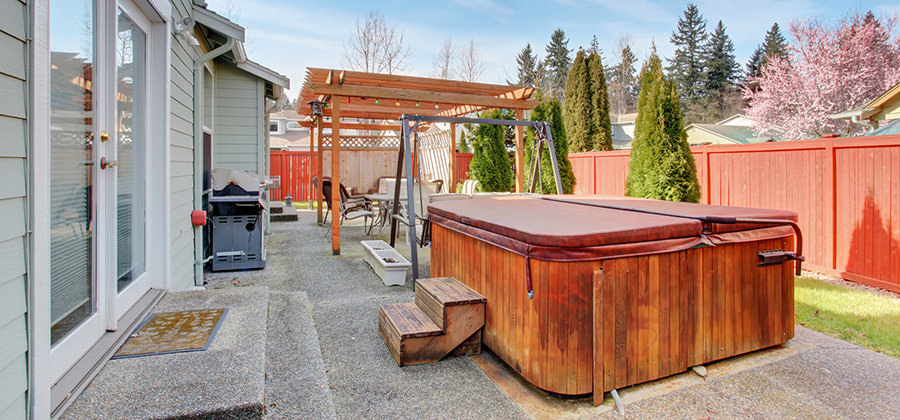
How does a hot tub cover work?
Hot tub covers might seem expensive for what they are but, once you delve beneath the surface you start to realize that they are not quite as simple as they seem. They usually come in two halves and the core of each half is a dense foam block. This is the part of the cover that keeps the heat in. Foam and moisture aren’t a great combination so, around each of the foam blocks there’s something called a vapor barrier. This prevents the foam block from soaking up moisture and becoming saturated. The blocks are encased in a vinyl cover and the cover is hinged in the middle to allow for easy opening.
Most covers have a slight taper to them so that they are sloping to allow rainwater to run off. This means that the quality of the hinges is of prime importance in how successfully and easily cover opens. Some hot tub covers also have a reinforcing galvanized steel strut in them to make sure that they are strong and rigid.
The vinyl cover has to be able to withstand a battering from the elements ranging from blazing sunlight to torrential rain and cold. The underside of the vinyl is continually attacked by the vapor from the hot tub so has to be extremely resistant to heat, moisture and
What are the best hot tub covers?
As with any major purchase there are a number of factors that you need to bear in mind when making your decision. Helpfully, there is a standards organization called ASTM International which regulates the quality of hot tub covers and you should check that your cover is approved by them before purchasing it. However, not all hot tub covers are made equal or will be right for you so you will need to do a bit of research! Anyone looking for a hot tub cover will be looking for something that is aesthetically pleasing and easy-to-use, has great thermal insulation properties, has a high build quality and is likely to last a long time. Here are some of the things that you should bear in mind.
Look for a high-density foam core – This is probably the most important consideration as it bears a direct correlation to how much insulation the cover will provide. The cover’s prime purpose is to insulate so this needs careful consideration. Foam cores are available in 1.0 pound, 1.5 pound and 2.0 pound and densities. You really need
You need a
Check out the
Make sure the hinge is strong – Things have a habit of breaking at points of stress and movement. Often hinges, zips, levers
Check the

How to measure a hot tub cover
Depending upon the manufacturer hot tub covers come in a number of pre made sizes as well as bespoke made to measure specifications. Obviously, it’s vitally important that the new cover is the right size so that it makes an effective seal and is easy to remove so take your time to measure as carefully as you can and then double check to be sure. Sometimes having someone else double check your work can save a lot of heart ache in the long term!
If you’re replacing a hot tub cover then it makes sense to measure the current cover and use it as a guide. However, you do need to bear in mind that the cover may have sagged a little in the middle or the hinge might have loosened over time which might mean that it gives a slightly inaccurate reading.
Even if you do measure the old cover and use it as a guide you should still measure the actual hot tub as well. Here’s how to do it:
Measure the length and width – You will need a long tape measure to do this. First of all, remove the old hot tub cover. Then, you need to make sure that you measure from the outer lips of the acrylic shell of the hot tub – take a lip to lip measurement.
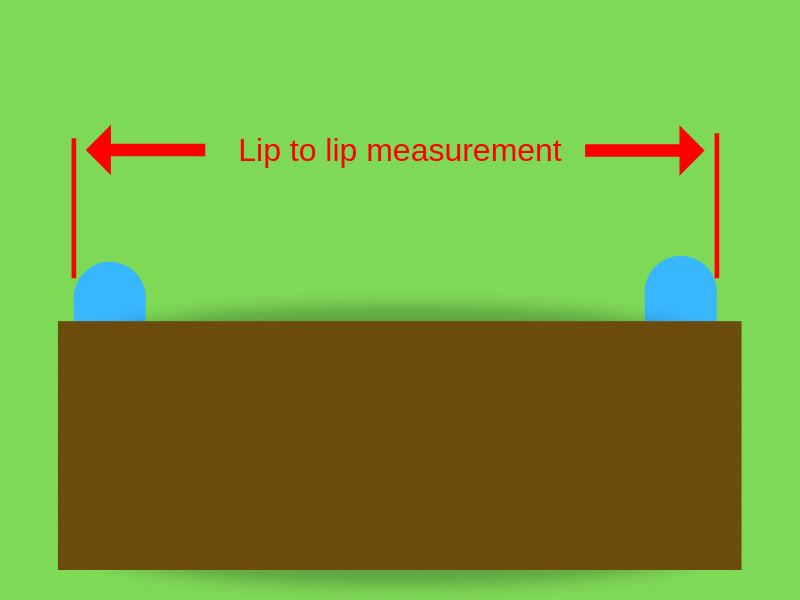
If you are using a flexible steel measuring tape you need to make sure that it doesn’t sag in the middle as this would give an incorrect reading. You could get somebody to help you and to hold onto the other end of the tape measure whilst you pull it tight. Alternatively, place a wooden batten over the hot tub and rest the tape measure on it.
Once you have got your measurements for both length and width add 1 inch to each which will give you 1/2 inch overhang all round once the new cover is in place.
Measure the corner radius – You will also need to measure the radius of the corners of the hot tub. This isn’t as difficult as it sounds and hopefully, the diagram below will make it clear. “R” is the measurement you need.
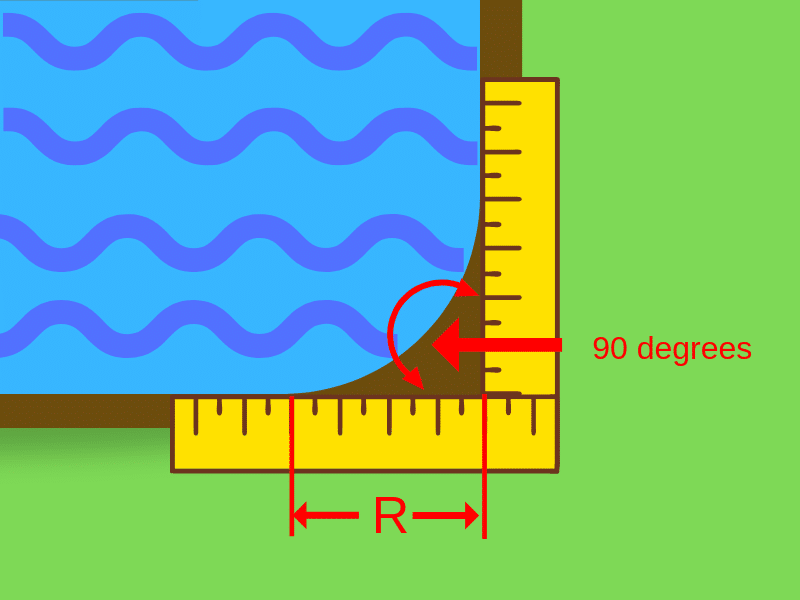
Basically, you will need a right angle square and, holding the square to the corner, you measure the radius by measuring the distance from the inside of the square to the point where it makes contact with the hot tub. Take your time over this and make sure that everything is square and level. Once you have your radius it’s important that you either round down the number or reduce by half an inch or so to give a little bit of leeway.
Remember that you need to reduce your corner radius numbers in order to make the radius bigger and to provide some overhang. For the length and width you do the opposite and add in order to produce more overhang.
Measure the skirt length – This is where your old hot tub cover will be really helpful. Measure the length of the skirt on the old cover from the bottom of the foam block to the edge of the skirt. Assuming that this fits correctly
Hot tub cover care and maintenance
There’s no doubt about the fact that a well cared for hot tub cover will last longer than one that’s been poorly maintained. There are two main issues that lead to hot tub covers needing to be replaced. The first one is that the vinyl outer covering hasn’t been cared for. This is a particular problem on the underside of the cover where the vinyl is attacked by steam and moisture. The second major problem occurs when the foam core becomes saturated with moisture. This means that the whole cover becomes extremely heavy and will probably sag in the middle as well as lose some of its thermal insulating properties. To a certain extent, both of these problems are inevitable but you can reduce them with careful care and regular maintenance. The final issue that will possibly lead to you needing to replace your cover is just general wear and tear. Obviously, the hinge and the skirt of cover will wear over time and, to a certain
Daily hot tub cover maintenance – Have a quick look at the cover on a daily basis and wipe off any debris and make sure
Weekly hot tub maintenance – It’s really important that you try to remove the cover completely on a weekly basis and allow it to dry out. This will avoid a buildup of moisture within the cover and, in the long term, mean that the foam core will remain dryer for longer and so the cover will last longer. Try to choose a warm sunny day and rest the cover off the hot tub in the sun for several hours to dry out on both sides. Once the cover is fully dried then you can clean the vinyl by spraying with a specially made marine vinyl cleaner. It’s also really important to wipe down the bottom of the hot tub cover as it’s really easy for chemical residue to build up here as well as mould and mildew. Use a solution of 1 to 10 parts of distilled white vinegar and water. Once you have finished cleaning both the top and the bottom of the
You can also apply a vinyl protectant or conditioner to give your cover some extra UV protection and these also help keep the cover soft and prevent it from cracking and leaking water. It’s also worth occasionally taking the foam core out of the vinyl casing and checking the vapour barrier. If you find any holes or damage to either the vinyl cover or the vapour barrier then you need to do a repair as soon as possible. Remember that you need to try and avoid letting the foam core collect moisture so you need to keep the cover as watertight and dry as possible.
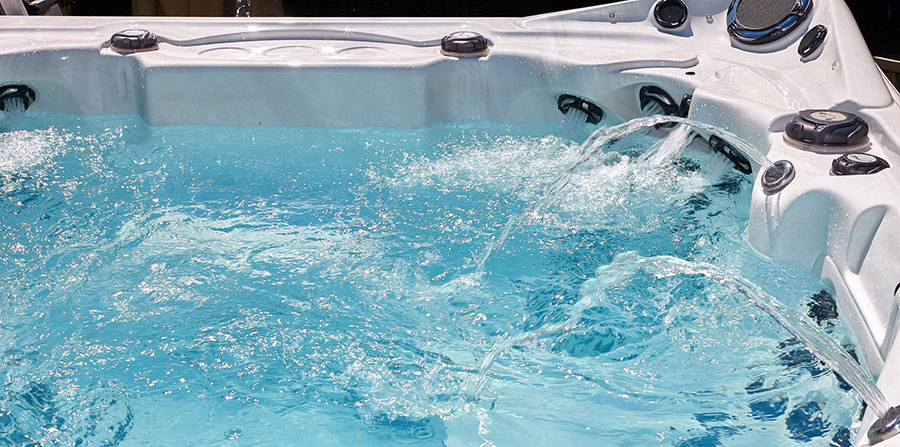
Using a hot tub cover lifter
With the best will in the
There are basically three types of hot tub cover lifters:
Manual pivot cover lifters – These are probably the most popular type. To use one of these you simply fold back the hot tub cover and then push back on it. The cover is supported by a bar and a lever system and the cover will lift off the hot tub and end up vertically at one end. The advantages of manual pivot covers are that they are relatively inexpensive and very easy to use. They are also easy to install. The main problem with them is that once the cover is lifted it will remain vertically above the hot tub on one side completely obscuring the view or blocking out the sun. This could be great if you are trying to gain some privacy or avoid sitting in the heat of the sun all day but may not be ideal. You can
Shelf cover lifters – these are really straightforward and cost-effective. These are basically just a large shelf which sits at the end of your hot tub. You slide the cover off the hot tub and over onto the shelf. The advantage of this is that it’s very simple to use and eliminates all lifting. Some models even have rollers which help once the hot tub is actually on the shelf making it a really easy process. The main drawback is that you will need a lot of room for the shelf at the end of your hot tub. It doesn’t block out the view as the cover remains horizontal but you will need an appreciable amount of space.
Hydraulic hot tub cover lifters – These work in exactly the same way as the manual pivot lifters but with the addition of hydraulics. This means that you really don’t need to put any effort into removing the cover at all. Obviously, they are more expensive than the other two options but they are by far the most effective solution. In some models, you end up with the same problem as the manual pivot lifters in that the cover remains at 90 degrees in a vertical position at the end of the hot tub. However, there are some models that will go through the full rotation allowing the cover to be horizontal at the end of the hot tub at the end of its movement. Again you need to think about the space issues for this.
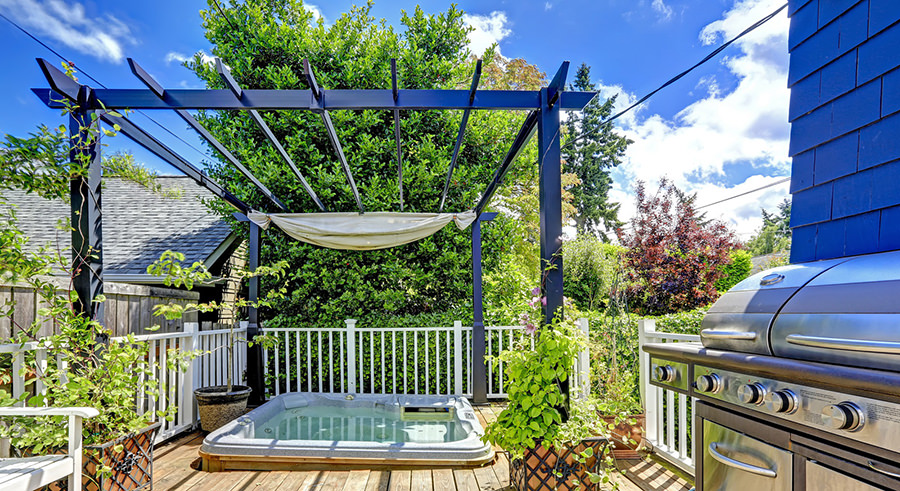
Related Questions
How do I fix a sagging hot tub cover? If your hot tub cover has started sagging it’s due to the fact that the foam core in the centre has become saturated with moisture. The weight of the water causes the sagging. It might well be time for a new cover but you can try removing the foam from the vinyl outer skin and allowing it to completely dry in the sun. Try to allow the air to circulate around the foam and be aware that it might take several hours to dry out. If the foam has become misshapen then there probably isn’t too much you can do about it but if it dried out successfully then it will probably be reusable. Before reassembling you need to work out where the moisture has got in and
How do I keep
Can you sit on a hot tub cover? Hot tub covers aren’t designed to hold the weight of a person either sitting or standing on them.
How long does a hot tub cover last? They are designed to last between 5 and 7 years. How long they actually last will depend on how well they are maintained. You will know that your cover needs to be replaced when it either physically starts to deteriorate (eg the hinge breaks or the vinyl is completely worn) or it becomes heavy and completely waterlogged.

